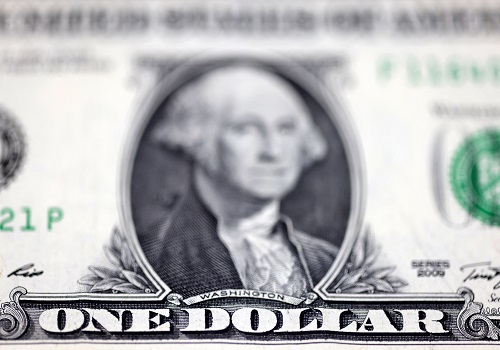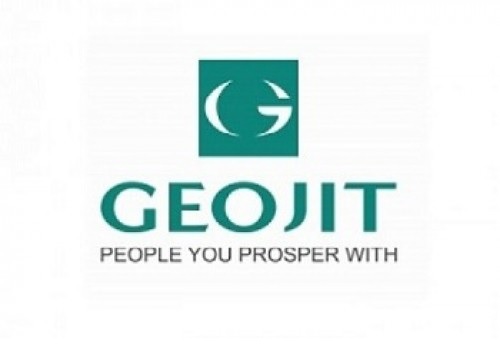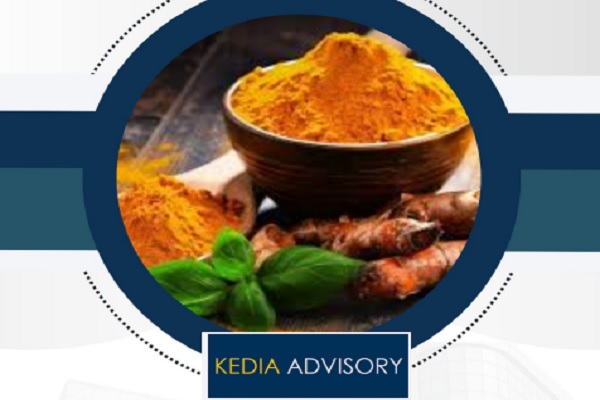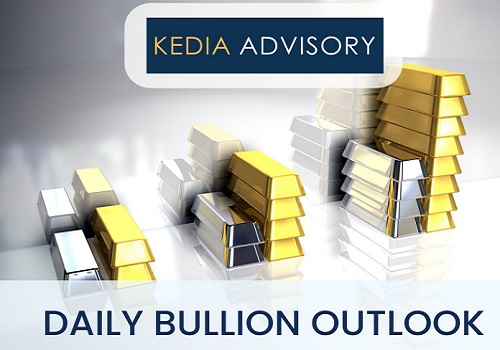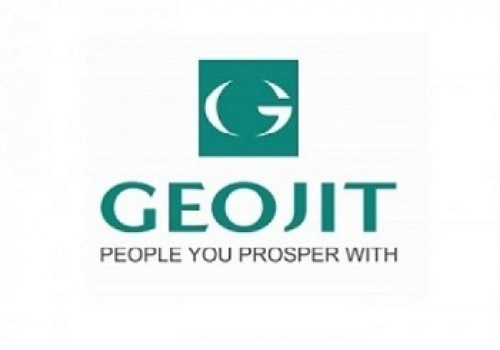Turmeric trading range for the day is 14174-15190 - Kedia Advisory

Gold
Gold prices declined by 0.78% to 92,441 as improved risk appetite stemming from progress in U.S.-China trade negotiations weighed on the safe-haven appeal of the metal. The announcement of a 90-day truce between Washington and Beijing, coupled with the U.S. decision to cut "de minimis" fees on small Chinese shipments, reduced geopolitical tensions, putting downward pressure on gold. However, the metal found some support from expectations of Federal Reserve rate cuts later this year, likely starting in September, following softer inflation and weaker economic data from the U.S. Physical gold demand saw a notable improvement across key Asian markets, driven by the recent price pullback. In India, dealers offered discounts up to $34/oz over official domestic prices, widening from $16 last week. Chinese dealers charged premiums of $9–$50/oz, while in Hong Kong and Singapore, premiums ranged from par to $2.50/oz. Japan saw smaller premiums between $0.25–$0.50/oz. According to the World Gold Council, global gold demand rose 1% year-on-year to 1,206 metric tons in Q1 2025, primarily due to a 170% surge in investment demand, notably through ETFs and gold bars. Bar and coin demand in China jumped 12% to 124.2 tons—its highest since Q2 2013. Technically, the gold market is under long liquidation, with open interest falling by 3.18% to 10,727. Immediate support lies at 91,520, and a break below could test 90,600. On the upside, resistance is seen at 93,455, with potential to test 94,470 if bullish momentum returns.
Trading Ideas:
* Gold trading range for the day is 90600-94470.
* Gold dropped as increased risk appetite from the U.S.-China trade agreement weighed.
* Washington and Beijing announced a 90-day pause, while they work out the details to end their tit-for-tat trade war.
* Physical gold demand improved across most key Asian hubs amid pullback in global prices.
Silver
Silver prices declined by 0.62% to 95,318, pressured by easing global trade tensions that reduced the demand for safe-haven assets. The dip followed encouraging developments in US-China trade talks, where both sides agreed to temporarily lower tariffs for a 90-day period. This move alleviated immediate fears of an escalating trade war, prompting investors to trim positions in safe havens like silver. However, lingering uncertainty about long-term trade resolutions and upcoming negotiations kept market caution intact. Additionally, a pullback in expectations for aggressive Federal Reserve rate cuts added to the bearish tone, although softer U.S. inflation data and a weaker dollar offered some offsetting support, making silver more appealing to international buyers. On the fundamental side, the global silver market is expected to post its fifth consecutive annual deficit in 2025, with the shortfall estimated to narrow by 21% to 117.6 million troy ounces. Industrial demand remains a key support, projected to rise 3% to over 700 million ounces, driven by green technology and electrification efforts. Despite stable overall demand near 1.2 billion ounces, a 6% drop in jewelry consumption—largely from India due to high prices—and reduced silverware demand could limit upside. Technically, silver is under fresh selling pressure with open interest rising 3.86% to 21,351. Immediate support is at 94,430, with further downside risk toward 93,540. Resistance is now pegged at 96,155, and a break above could open the path to test 96,990.
Trading Ideas:
* Silver trading range for the day is 93540-96990.
* Silver declined as easing global trade tensions reduced demand for safe-haven assets.
* Reduced geopolitical risk has led markets to dial back expectations for aggressive Federal Reserve rate cuts.
* However, recent data pointed to easing inflationary pressures in the US, providing some offsetting support to precious metals.
Crude oil
Crude oil prices climbed by 1.52% to 5,351, buoyed by easing U.S.-China trade tensions, which reignited optimism in global markets. Positive sentiment stemmed from constructive talks and signs of progress on a trade agreement, reducing investor concerns about prolonged economic disruptions. However, this bullish momentum was tempered by growing supply concerns, particularly surrounding Iran and OPEC+. U.S. President Trump hinted at nearing a nuclear deal with Iran, although sources indicated several unresolved issues remain. Meanwhile, the U.S. Energy Information Administration (EIA) projected a moderate increase in OPEC+ output, raising its forecast for 2025 group supply to 42.9 million barrels per day, up from 42.8 million bpd previously. The EIA also reported a mixed inventory picture: U.S. crude stocks rose by 3.5 million barrels to 441.8 million barrels, while gasoline and distillate inventories fell by 1 million and 3.2 million barrels respectively. A significant decline at the Cushing hub and increased refinery activity suggest stronger domestic demand and seasonal upticks in fuel consumption. The International Energy Agency (IEA) trimmed its oil demand growth forecast for the remainder of 2025 to 650,000 bpd due to economic headwinds and rapid EV adoption. Technically, the market is showing signs of fresh buying, with open interest increasing 8.8% to 7,773. Crude oil has immediate support at 5,275, and a break below could test 5,199. Resistance is now seen at 5,393, with potential to move toward 5,435 if momentum persists.
Trading Ideas:
* Crudeoil trading range for the day is 5199-5435.
* Crude oil prices edged up on easing U.S.-China trade tensions.
* IEA hikes supply growth forecast, eyes surplus this year and next.
* EIA said it expects OPEC+ to keep production below the group's current target path.
Natural gas
Natural gas prices declined by -2.33% to 285.3, pressured by a slower-than-expected drop in output, reduced flows to LNG export terminals, and a subdued demand outlook. While production in the Lower 48 U.S. states fell to an average of 103.7 billion cubic feet per day (bcfd) so far in May—down from the April record of 105.8 bcfd—the decrease was smaller than anticipated, suggesting ample supply. Demand is expected to remain relatively steady around 96.3 bcfd this week and next, before easing slightly to 94.0 bcfd. LNG exports also showed a pullback, averaging 15.1 bcfd so far in May, compared to the April record of 16.0 bcfd, signaling a decline in export-driven demand. Storage levels remain comfortable, with U.S. utilities injecting 110 Bcf into storage for the week ending May 9, in line with expectations. Current inventories stand at 2,255 Bcf, which is 57 Bcf above the five-year average, giving utilities breathing room ahead of peak summer cooling demand. The U.S. Energy Information Administration (EIA) remains optimistic on the long-term trend, projecting record highs for both production and consumption in 2025. Technically, the market is experiencing fresh selling pressure, with open interest rising by 1.56% to 16,301 as prices declined 6.8. Support is seen at 280.9, with further downside possible to 276.5. On the upside, resistance is likely at 292.5, with a break above potentially testing 299.7.
Trading Ideas:
* Naturalgas trading range for the day is 276.5-299.7.
* Natural gas dips on smaller output drop, weaker LNG flows, and soft demand outlook
* Gas stockpiles were around 3% above the five-year (2020-2024) normal.
* Average gas output in the Lower 48 U.S. states fell to 103.7 bcfd so far in May.
Copper
Copper prices declined by -1.18% to 852.1, weighed down by waning optimism over the recent U.S.-China trade truce and renewed concerns around oversupply. The International Copper Study Group (ICSG) sharply revised its 2025 global surplus forecast to nearly 300,000 tonnes, citing a mix of increasing production and slowing global demand. The downward revision in copper usage growth reflects lingering uncertainties in global trade policy, which continue to cloud the demand outlook. Inventory data also added to the bearish sentiment. Shanghai Futures Exchange warehouses reported a substantial 34% rise in copper inventories to 108,142 tonnes, marking the first net weekly gain since mid-March. This comes after three consecutive weeks of significant withdrawals, which had previously raised concerns about a potential price spike. Globally, the refined copper market posted a surplus of 61,000 metric tons in February, slightly lower than January's 90,000-ton surplus. Year-to-date, the surplus stood at 150,000 metric tons, suggesting a continuation of supply outpacing demand. In China, copper imports in April held steady at 438,000 metric tons year-on-year, while imports for the first four months of 2025 declined by 3.9%. Technically, copper is under fresh selling pressure, with open interest climbing by 3.75% to 4,066 as prices fell 10.15. Immediate support lies at 847.9, with further downside possible to 843.7. Resistance is seen at 859.9, and a move above this could open the path to 867.7.
Trading Ideas:
* Copper trading range for the day is 843.7-867.7.
* Copper edged down amid fading optimism over the US-China trade truce.
* Copper inventories in SHFE warehouses rose 34.0 % from last Friday.
* ICSG doubled its global surplus forecast for 2025 to nearly 300,000 tonnes
Zinc
Zinc prices declined by -0.93% to settle at 256.65, as fading optimism from the U.S.-China 90-day trade truce and weaker demand from price-sensitive consumers, particularly in China, weighed on market sentiment. The initial lift from the tariff pause has subsided, with investors shifting their attention to the broader global economic outlook. China's economic indicators and consumer activity remain a key influence on zinc, and softer-than-expected consumption is curbing any upward momentum. Despite bearish sentiment, the supply landscape presents a more complex picture. While London Metal Exchange (LME) zinc inventories recently pulled back to 169,850 metric tons after reaching a three-month high in mid-April, concerns linger around global ore supply. Notably, disruptions have been reported at a Russian mine operated by Zijin Mining, though no production halt has been confirmed yet. Market expectations had been leaning toward increased zinc supply due to rising treatment charges (TCs), but their impact on smelting output is yet to be fully realized. From a macro perspective, the International Lead and Zinc Study Group (ILZSG) projects a surplus in the global refined zinc market for 2025. Refined output is expected to grow by 1.8% to 13.73 million tons, outpacing the 1% increase in demand. Technically, the zinc market is undergoing long liquidation, with open interest declining by 0.58% to 1,888. Zinc now finds support at 254.9, with a potential test at 253 if selling pressure persists. Resistance is seen at 259.6, and a breakout could lead to 262.4.
Trading Ideas:
* Zinc trading range for the day is 253-262.4.
* Zinc slips as weak China demand offsets gains from US-China trade truce
* Zinc inventories in SHFE warehouses monitored dropped 1.6% from last Friday.
* In refined zinc, global output grows by 1.8% to 13.73 million tons - ILZSG
Aluminium
Aluminium prices declined by -0.64% to settle at 239.5, pressured by growing uncertainty over long-term demand prospects and fading optimism from the 90-day tariff pause between the U.S. and China. Although initial hopes of eased trade tensions provided some support, market sentiment has weakened as demand concerns resurface. On the supply side, aluminium inventories at Japan’s three major ports rose to 320,300 metric tons in April, up 3.4% month-on-month, reflecting ample availability in key Asian hubs. Additionally, improved alumina supply across Southeast Asia has eased input constraints that plagued the industry in 2024, reducing production costs and supporting smelter activity. In China, exports of unwrought aluminium and aluminium products surged by 17% in the first ten months of 2025 compared to the same period last year, underlining strong international demand. Domestically, aluminium production increased by 2.6% year-on-year in April, though output fell 2.9% month-on-month. The share of liquid aluminium dipped slightly to 74%, suggesting modest fluctuations in product mix. Looking ahead, China’s aluminium capacity is expected to remain high, with the first batch of capacity replacement projects in Shandong and Yunnan commencing output in May. Technically, the aluminium market is undergoing long liquidation, indicated by a steep 19.35% drop in open interest to 2,710 contracts. Aluminium is now finding support at 237.8, with further downside risk toward 236.1. On the upside, resistance lies at 241, with a potential test of 242.5 if buying interest returns.
Trading Ideas:
* Aluminium trading range for the day is 236.1-242.5.
* Aluminium prices dropped amid uncertainty over longer-term demand prospects.
* The initial optimism about the 90-day pause agreed by Beijing and Washington has faded.
* Japan's April aluminium stocks rise 3.4% m/m
Cottoncandy
Cottoncandy prices declined by -0.53% to settle at 54,160, as traders booked profits following recent gains driven by concerns over domestic supply tightness. The downward move came amid a 2.82% drop in open interest, signaling long liquidation pressure in the market. Despite the price correction, fundamentals remain supportive due to a projected decline in India’s cotton output. The Cotton Association of India (CAI) revised its 2024–25 crop estimate lower by 4 lakh bales to 291.30 lakh bales of 170 kg each, with significant production losses anticipated in Maharashtra. Cotton imports for the 2024–25 season are now expected to more than double to 33 lakh bales, up from last season’s 15.20 lakh bales, as supply concerns intensify. CAI estimates imports of 25 lakh bales have already arrived by the end of March. Meanwhile, total cotton supply till March end is pegged at 306.83 lakh bales, while stocks at the end of March stood at 127.83 lakh bales. Cotton exports are projected to fall sharply to 16 lakh bales from 28.36 lakh bales in the previous season, with closing stocks expected at just 23.49 lakh bales by September 2025. On the global front, the U.S. Department of Agriculture reported lower production and consumption estimates, with a 100,000-bale rise in ending stocks to 5.0 million bales. Technically, cottoncandy is witnessing long liquidation. Immediate support lies at 53,740, and a break below could push prices toward 53,310. Resistance is seen at 54,670, with a potential test of 55,170 on bullish momentum.
Trading Ideas:
* Cottoncandy trading range for the day is 53310-55170.
* Cotton dropped on profit booking after prices gained as CAI expects a shrinkage in the domestic crop further.
* Cotton exports for the 2024-25 season are pegged at 16 lakh bales, lower by 12.36 lakh bales over previous year’s 28.36 lakh bales.
* The closing stock for 2024-25 season at end of September 2025 is estimated lower at 23.49 lakh bales from same period last year’s 30.19 lakh bales. I
* In Rajkot, a major spot market, the price ended at 26034.55 Rupees dropped by -0.42 percent.
Turmeric
Turmeric prices edged higher by 1.02% to settle at 14,634, supported by concerns over lower crop yields and limited arrivals despite an increase in acreage. The area under turmeric cultivation this season stands at 3.30 lakh hectares, a 10% increase over last year. However, production is not expected to rise proportionately due to adverse weather conditions, particularly untimely rains, which have negatively impacted crop quality and yields in key regions like Nanded. Reports suggest yields may be 10–15% lower than last year’s output of 10.75 lakh tonnes, with rhizome growth and size below optimal levels and some cases of crop rot observed. While production concerns are lending price support, the upside remains capped due to a significant increase in arrivals and subdued export demand. Arrivals surged to 57,500 quintals compared to 29,860 quintals in the previous session, reflecting improved supply from harvesting regions. Meanwhile, export demand is showing mixed trends. Turmeric exports during April–February 2025 rose 11.51% year-on-year to 161,229.56 tonnes. However, February 2025 exports saw a 2.97% decline compared to the same month in 2024. On the import front, India’s turmeric imports rose significantly by 55.21% during April–February 2025, indicating strong domestic demand amid lower local output. Technically, the market is witnessing fresh buying with a slight increase in open interest by 0.25% to 16,200. Immediate support is seen at 14,404, and a break below could push prices to 14,174. Resistance is expected at 14,912, and a move above this could lead to testing 15,190 levels.
Trading Ideas:
* Turmeric trading range for the day is 14174-15190.
* Turmeric gains amid persistent concerns about low arrivals and lower production estimates.
* However upside seen limited due to increased arrivals and owing to weak export enquiries.
* Total arrivals rose to around 57,500 quintals, up significantly from 29,860 quintals in the previous session.
* In Nizamabad, a major spot market, the price ended at 14602.35 Rupees gained by 0.63 percent.
Jeera
Jeera prices declined by -1.69% to settle at 21,460 amid subdued buying from domestic buyers and weak export demand. The fall is largely attributed to the conclusion of the retail season and limited activity from foreign buyers. Pressure on prices was further compounded by comfortable supplies and tepid export interest amid adequate stocks. Total arrivals at major mandis rose to 32,900 bags from 28,000 bags in the previous session, adding to the supply-side pressure. Additionally, the start of the new cumin crop in Gujarat has been delayed by about a month due to unfavorable weather, impacting overall market sentiment. Despite this, the current season’s production is expected to be on par with last year owing to better crop conditions and good sowing in major growing regions like Gujarat and Rajasthan. Jeera exports during April to February 2025 rose sharply by 62.55% to 195,165 tonnes compared to the previous year, though monthly exports in February 2025 dropped by nearly 24% from January. Imports during April to February 2025 fell steeply by 93.7%, reflecting lower dependence on foreign supply. Meanwhile, import volumes in February also saw significant declines compared to previous months and last year. Technically, the market is under fresh selling pressure as open interest rose by 3.98% to settle at 6,501, while prices dropped by 370. Immediate support is seen at 21,290, and a break below this level could test 21,130. On the upside, resistance is likely at 21,720, and a move above this could lead to testing 21,990.
Trading Ideas:
* Jeera trading range for the day is 21130-21990.
* Jeera dropped due to lower buying from domestic buyers and subdued export demand.
* Pressure also seen due to comfortable supplies and tepid export interest amid adequate existing stocks.
* In Feb 2025 around 12,996.88 tonnes of jeera were exported as against 17,083.31 tonnes in Jan 2025 showing a drop of 23.92%.
* In Unjha, a major spot market, the price ended at 21989.8 Rupees dropped by -0.64 percent.
Views express by all participants are for information & academic purpose only. Kindly read disclaimer before referring below views


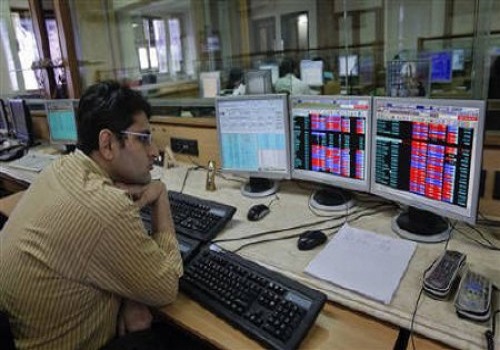
.jpg)









